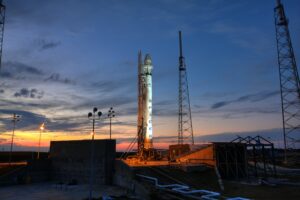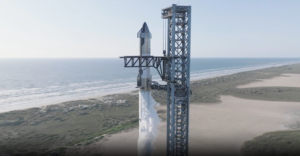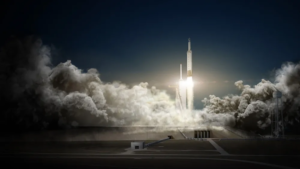
SpaceX Is Getting Ready To Launch Starship Next Month!
Just two months after Starship’s second test flight, SpaceX is already closing in on the next attempt. New insights from SpaceX along with the company’s progress suggests they are planning to receive a launch license next month. If so, they intend to attempt a third flight with improved hardware just days after.
Thanks to improvements on the pad among other upgrades, the time between the 2nd and third flight is setting up to be much shorter than the last attempt. In the time since the second flight, SpaceX has continued to investigate what went wrong and how to fix it. By now the company is confident in determining the anomaly on the last flight and working to ensure it doesn’t happen again.
If successful, this could be the first flight where the upper stage makes it across the globe before attempting to reenter the atmosphere. So far on each flight the company has made progress and gotten further than the prior attempt. Here I will go more in-depth into the new launch date reports, the final steps before a second flight, some of the changes made, and more.
Starship IFT-3

Just over a week ago on January 9th, during a media brief, Jessica Jensen, vice president of customer operations and integration at SpaceX, provided some insight on the company’s plans and the next flight test. In a quote, she said, “From a hardware readiness perspective, we are targeting to be ready in January,”. To add to that, when talking about a launch license she went on to say, “We’re on track for that. We’re expecting that license to come in February. So, it’s looking like Flight 3 will occur in February.”
This obviously is a very good sign and coming from a source that has quite a bit more information than the public. Based on these comments among others, it seems that a launch toward late February is well within reach. If not then, sometime in March would be very likely. Beyond what was said during this briefing, SpaceX has also shared some positive information.
Specifically, a few days ago Elon provided a company update where he shared info on SpaceX’s plans, achievements, etc both for the Falcon 9 and even Starship. At one point when talking about the last Starship test flight he said, “Ironically, if it had had a payload, it would have made orbit. Because the reason that it didn’t make it to orbit is that we vented the liquid oxygen, and the liquid oxygen ultimately lead to fire and an explosion. Because we wanted to vent the liquid oxygen, and we normally wouldn’t have that liquid oxygen if we had a payload” he said. In other words, not long after stage separation when the upper stage was nearing the end of the second stage burn, SpaceX is confident that had there been a payload and no need to vent, it would have continued on without any problems.
Obviously, there still was an error no matter how you put it considering you don’t want your rocket exploding just because you vent propellant, however, it is a good sign. Besides this issue, SpaceX seems to be pretty confident regrading the other aspects of launch and improvements between IFT-2 and the upcoming flight. This means there is a real possibility of a successful test flight in only months. Granted, there is still a decent amount of work left to do between now and then.
One significant difference between the work needed from IFT 1 to 2 and 2 to 3 is the pad. As we know the first Starship flight destroyed Stage 0 creating a large crater and launching debris in every direction. This time around the pad held up very well to the point where it has already been used for a handful of tests. With this step out of the way, the limiting factor when it comes to time between launches really just depends on launch license approval and initial stage testing.
A few weeks ago at the very end of 2023, SpaceX completed a static fire of both the booster and ship expected to attempt the next Starship flight. The booster completed its test on the actual pad while the upper stage did its test on a separate mount. Both provided promising results and also confirmed that the pad and deluge system were working properly. In the next few weeks, we can expect to hear more about the upcoming launch and whether or not they think approval is coming soon. Other than that they are practically ready on a hardware standpoint making a launch next month realistic.
The Next Steps

At this point, many believe SpaceX is genuinely getting close to a successful integrated test flight. With a host of large projects and missions relying on this vehicle in the coming years, the faster they can complete this first major milestone, the sooner they can begin more complicated operations.
For example, during the media briefing that I mentioned prior, she added that SpaceX was “working towards” a demonstration of propellant transfer capabilities on that flight through NASA’s Tipping Point technology program. In that test, SpaceX would transfer cryogenic propellant from a “header” tank within Starship to its main tank. This initial operation is meant to be a precursor to later tests of transferring propellant from one Starship to another in orbit.
For Artemis III, SpaceX and the Starship vehicle is expected to land humans on the Moon after docking with Orion in lunar orbit. Before it can reach the Moon however, it needs to be filled with propellant in Earth orbit from a number of Starship tankers. As far as how many tankers are needed, Musk has said that no more than eight, and perhaps as few as four would be needed. On the other hand, at an advisory committee meeting in November, the assistant deputy associate administrator for NASA’s Moon to Mars Program, said the number of tanker launches was in “the high teens.”
No matter how many tankers, the process of transferring propellant in orbit is quite the process and something SpaceX needs to perfect with Starship prior to the Artemis missions. Once Starship successfully reaches orbit, testing this hardware and rendevous will be one of the major next steps.
In addition to Artemis, many are confident that if SpaceX were to successfully complete IFT-3, meaning Starship coasts around the globe and splashes down near Hawaii, a long list of customers would begin announcing future plans with the vehicle. While not technically orbit, a successful integrated test flight would demonstrate that this vehicle is extremely capable and on the cusp of incredible opportunity.
In terms of what to expect on the upcoming flight, it should be very similar to the two previous flight attempts. On the day of launch, main operations will begin two hours before liftoff with the SpaceX Flight Director conducting a poll and verifying go for propellant load. Just 21 minutes later, Booster LOX (liquid oxygen) will begin loading into the first stage. At the same time, the Booster Fuel load (liquid methane) will also start flowing to the booster. 1 hour and 22 minutes prior to launch and SpaceX will begin loading liquid methane into the upper stage. 5 minutes later and this process will begin with the liquid oxygen. This process will continue over the next hour approximately until the rocket is full of propellant.
Next, with just 16 minutes and 40 seconds left on the clock, the Raptor begins engine chill down on the booster. Over the next 15 minutes, SpaceX continues to thoroughly monitor everything going on and make sure the rocket is ready. With just 40 seconds left before liftoff, the fluid interfaces begin their ventdown sequence. At T – 8 seconds, all of the Super Heavy booster Raptor engine startup sequences begin. Finally, as the clock hits 0, Starship lifts off and soon clears the tower.
Assuming Starship clears the tower, it will continue to accelerate and gain altitude. Just 55 seconds after liftoff and the rocket will reach Max q, the moment of peak mechanical stress on the rocket. For the next 2 minutes, Super Heavy will continue to fire its engines and accelerate Starship into position. 2 minutes and 49 seconds in and the Booster main engine cutoff occurs. We will then see the rocket attempt a hot staging separation where the upper stage ignites its engines while still attached to Super Heavy. Once separated, the booster boostback startup burn commences 3 minutes and 11 seconds after liftoff. For the next whole minute, this burn continues until T + 4 minutes and 6 seconds. For the next couple of minutes, the booster will fall back toward Earth picking up a significant amount of speed. At T + 7 minutes and 40 seconds, the booster landing burn startup occurs. This burn lasts for the next 31 seconds before its cutoff and the booster falls into the ocean in the Gulf of Mexico.
At T + 9 minutes and 20 seconds, Starship cuts off its engines. For the next hour and 8 minutes, the upper stage will be in its coast phase. This is until T + 1 hour and 17 minutes when Starship begins to enter the atmosphere. 11 minutes after the start of reentry and the vehicle is transonic. Finally, a full 1 and a half hours after liftoff, and the Starship upper stage is expected to splash down in the Pacific Ocean. This is the exact flight profile assuming everything goes perfectly. Obviously, a lot could go wrong on this test flight, but this is the goal. We have seen consistent improvement from the last two flights and if SpaceX continues that pattern on the upcoming test, it could be successful.
Conclusion
SpaceX could be just over a month away from the third integrated flight test of Starship. Thanks to improvements to the pad, vehicle, and testing time, the company is practically ready and just needs approval. We will have to wait and see how it progresses and the impact it has on the space industry.



